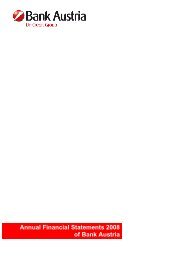Annual Financial Statements 2010 of Bank Austria
Annual Financial Statements 2010 of Bank Austria
Annual Financial Statements 2010 of Bank Austria
Create successful ePaper yourself
Turn your PDF publications into a flip-book with our unique Google optimized e-Paper software.
Consolidated <strong>Financial</strong> <strong>Statements</strong> in accordance with IFRSs<br />
A – Accounting policies (CoNTINuED)<br />
IFRS 9 <strong>Financial</strong> Instruments: Classification and Measurement<br />
The issued version <strong>of</strong> IFRS 9 reflects the first phase <strong>of</strong> the IASB project to replace IAS 39 and deals with the classification and measurement <strong>of</strong><br />
financial assets as defined in IAS 39. The standard is to be applied for financial years beginning on or after 1 January 2013. In further phases the<br />
IASB will deal with the classification and measurement <strong>of</strong> financial liabilities, hedging relationships and derecognition. The project is expected to<br />
be completed in early 2011. Application <strong>of</strong> the first phase <strong>of</strong> IFRS 9 affects the classification and measurement <strong>of</strong> financial assets <strong>of</strong> the Group.<br />
For a comprehensive presentation <strong>of</strong> potential effects, <strong>Bank</strong> <strong>Austria</strong> will only quantify the effects in conjunction with the other phases once they<br />
have been published.<br />
IFRIC 14 Prepayments <strong>of</strong> a Minimum Funding Requirement (amended)<br />
The amended IFRIC 14 is to be applied retrospectively for financial years beginning on or after 1 January 2011. The amendment provides guidance<br />
on how to determine the recoverable amount <strong>of</strong> a net pension asset. Under the amendment, entities may treat prepayments <strong>of</strong> a minimum<br />
funding requirement as an asset. The amendment is not expected to have any effects on the consolidated financial statements <strong>of</strong> <strong>Bank</strong> <strong>Austria</strong>.<br />
IFRIC 17 Distributions <strong>of</strong> Non-cash Assets to Owners, and IFRIC 18 Transfers <strong>of</strong> Assets from Customers<br />
The amendments issued by the IASB to IFRIC 17 and IFRIC 18, which are required to be applied for the first time for financial years beginning on<br />
or after 1 July 2009, were not applied in the <strong>Bank</strong> <strong>Austria</strong> Group.<br />
IFRIC 19 Extinguishing <strong>Financial</strong> Liabilities with Equity Instruments<br />
IFRIC 19 is to be applied for financial years beginning on or after 1 July <strong>2010</strong>. The interpretation makes it clear that equity instruments issued to<br />
a creditor to extinguish a financial liability are “consideration paid”. The equity instruments issued are measured at fair value. If fair value is not<br />
reliably determinable, the equity instruments issued are to be measured at the fair value <strong>of</strong> the liability extinguished. Gains and losses are immediately<br />
recognised in the income statement. The application <strong>of</strong> this interpretation will have no effect on the consolidated financial statements <strong>of</strong><br />
<strong>Bank</strong> <strong>Austria</strong>.<br />
A.5 – Significant accounting policies<br />
Business combinations<br />
When a subsidiary is acquired, the fair values <strong>of</strong> its identifiable assets, including identifiable intangible assets, and liabilities are <strong>of</strong>fset against the<br />
cost <strong>of</strong> acquisition. The difference between the cost <strong>of</strong> acquisition and the fair value <strong>of</strong> net assets is recognised in the balance sheet as goodwill<br />
if such difference cannot be attributed to intangible assets, e.g. a customer base. Pursuant to IFRS 3 and IAS 36, goodwill is not amortised. Goodwill<br />
arising on business combinations after 1 April 2004 is stated in the currency <strong>of</strong> the acquired company and translated at the closing rate.<br />
Goodwill is tested for impairment at least once a year.<br />
As at the date <strong>of</strong> acquisition, equity <strong>of</strong> foreign subsidiaries which prepare their financial statements in foreign currency is translated into euros.<br />
Gains and losses arising on the foreign currency translation <strong>of</strong> equity <strong>of</strong> foreign subsidiaries are recorded directly in equity as at the dates <strong>of</strong> the<br />
subsequent statements <strong>of</strong> financial position.<br />
Goodwill arising on acquisitions <strong>of</strong> subsidiaries and other equity interests before 1 January 1995 has been <strong>of</strong>fset against retained earnings.<br />
When a subsidiary is acquired, the calculation <strong>of</strong> non-controlling interests is based on the fair values <strong>of</strong> assets and liabilities.<br />
Foreign currency translation<br />
The consolidated financial statements are prepared in euro. Foreign currency transactions are translated into euro on initial recognition by applying<br />
the exchange rate at the date <strong>of</strong> the transaction.<br />
Foreign currency translation is performed in accordance with IAS 21. Monetary assets and liabilities denominated in currencies other than the<br />
euro are translated into euros at market exchange rates prevailing at the end <strong>of</strong> the reporting period. Forward foreign exchange transactions not<br />
yet settled are translated at the forward rate prevailing at the end <strong>of</strong> the reporting period.<br />
For the purpose <strong>of</strong> foreign currency translation <strong>of</strong> the financial statements <strong>of</strong> foreign subsidiaries, which are prepared in a currency other than the<br />
euro, the middle exchange rate prevailing at the end <strong>of</strong> the reporting period has been applied to items in the statement <strong>of</strong> financial position and<br />
the annual average exchange rate has been applied to income statement items.<br />
<strong>Bank</strong> <strong>Austria</strong> · <strong>Annual</strong> <strong>Financial</strong> <strong>Statements</strong> <strong>2010</strong><br />
62
















